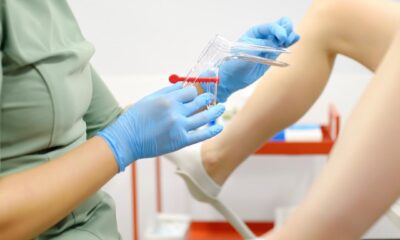Blog
Vaginal Aging: What You Need to Know

When we age, our bones get weaker, our body structure changes, and we don’t remain as healthy as we used to be. The same way, the vaginal area also ages. It loses collagen in the skin, and the muscles get weaker. If a woman goes through a single heavy childbirth or multiple deliveries, it plays a very important role in causing a loose vagina.
Most women remain silent and don’t discuss this issue. They feel shameful about talking about this intimate area, and they don’t seek help from dermatologists or cosmetic gynecologists, even though these issues play an important role in their lives. So before we talk about the solution, let’s go through some signs and symptoms women face when their vagina starts to age.
Vaginal Aging: Signs & Symptoms
- Loose vaginal canal due to frequent intercourse
- Stretched vaginal canal after childbirth
- De-shaped vaginal canal due to various positions
- Wrinkles and sagging skin around the vaginal area
- Dark pigmentation on vaginal and anal areas
- Unpleasant or unattractive appearance of the vagina
- No pleasure or sensitivity during intercourse
- Feeling ashamed or experiencing low confidence during intimacy
These are some common early signs and symptoms that women usually don’t talk about due to the sensitivity of the topic, which directly affects their personality and confidence.
Emotional Trauma & Vaginal Laxity
Breakups and Intercourse
Sometimes a woman falls in love with the wrong person who uses her physically, and after 3 to 4 years of an unhealthy relationship, leaves her. This kind of trauma often ages the vagina earlier due to repeated, careless intercourse and emotional stress.
Divorce Issues
In some cases, unstable relationships between husband and wife result in divorce. During this time, after too much intercourse, a woman may face problems like vaginal loosening. Often, dishonest or unfaithful males cause this for their own pleasure, without understanding or loving their partner. Later, they blame their partner’s vaginal appearance, which deeply impacts a woman’s self-esteem.
While these points may feel sensitive to discuss, they are important for building awareness and understanding around vaginal looseness and related concerns, so we can develop a better and more accepting approach toward treatments.
How to Start Vaginal Tightening Treatment
If you are facing any of the symptoms mentioned above — like your vaginal canal feels de-shaped, you feel pain during intercourse, or you don’t feel anything inside when being physical with your partner — and in some cases, if your partner complains of no satisfaction, then it’s time to seek help from a qualified and experienced doctor.
Only a professional cosmetic gynecologist or plastic surgeon can guide you after proper examination and offer non-surgical or surgical options depending on your condition.
Cost of Vaginal Tightening Treatment in Pakistan
The cost of vaginal tightening depends on the procedure your doctor recommends after a detailed examination.
- Non-surgical treatments (such as laser or radiofrequency tightening):
Typically range from Rs. 40,000 to Rs. 60,000. - Surgical treatments (like vaginoplasty):
Range between Rs. 75,000 to Rs. 500,000, depending on the complexity and the procedures added.
Many women also add vaginal rejuvenation surgeries like:
- Vaginoplasty – tightening the vaginal canal
- Labiaplasty – reshaping of labia minora or labia majora, especially after excessive intercourse or childbirth which changes their appearance
Best Clinic for Vaginal Tightening in Pakistan
It doesn’t matter whether you’re living in Islamabad, Karachi, Lahore, or any other part of the world — if you are facing vaginal laxity or looseness, the best clinic to consult is Aesthedoc Clinic.
Here, you’ll find plastic surgeons and aesthetic gynecologists who listen to your concerns in detail and offer the most suitable solution, whether it’s a surgical or non-surgical option. The clinic maintains a safe, confidential, and professional environment, helping women restore their confidence, health, and intimate satisfaction.
Final Thoughts
Vaginal aging is a natural part of life, just like aging in other parts of the body. But you don’t have to suffer in silence. Many advanced and safe treatments are available now to help you regain your confidence, pleasure, and comfort in intimate life.
Don’t feel ashamed — feel empowered to take the next step toward healing and rejuvenation.
Blog
O‑Shot + Laser Combo for Vaginal Rejuvenation

If you’re looking for a powerful, synergistic approach to intimate wellness, the O‑Shot + Laser combo at Aesthedoc Clinic in Rawalpindi is one of the most advanced, evidence-based treatments available today. This combination therapy leverages the regenerative power of Platelet-Rich Plasma (PRP or “O‑Shot”) with the collagen-stimulating and tightening effects of fractional laser therapy, offering deeper rejuvenation, improved sensation, and enhanced vaginal health.
Under the skilled care of Dr. Naila Frukh, a fellowship-trained cosmetic gynecologist, we deliver this treatment in a safe, confidential, and medically guided environment.
This guide explains:
- What exactly the O‑Shot is
- How combining PRP with laser creates a superior effect
- Key benefits of the combo
- Treatment process & what to expect
- Safety, research evidence & risks
- Ideal candidates for the combo
- Cost guide for Rawalpindi
- Why Aesthedoc Clinic is the right place for this
- How to book your consultation
What Is the O‑Shot (PRP for Vaginal Health)?
The O‑Shot refers to the injection of Platelet-Rich Plasma (PRP) into specific areas of the female genital tract — often the vaginal wall, clitoral region, or labia. PRP is derived from your own blood and is rich in growth factors, cytokines, and other signaling molecules that can:
- Promote tissue regeneration
- Stimulate collagen and elastin production
- Enhance blood vessel formation (angiogenesis)
- Improve moisture and lubrication
These effects can help in boosting sexual sensitivity, improving lubrication, and supporting tissue health.
Why Combine O‑Shot (PRP) with Laser Therapy?
Using PRP together with fractional laser therapy produces a synergistic effect:
- Enhanced Tissue Remodeling
- The laser creates micro-injuries (microthermal zones) in the vaginal tissue, which initiates a healing process.
- PRP amplifies this repair response by delivering concentrated growth factors to these micro-injured areas.
- Clinical research shows that combining PRP with fractional laser enhances collagen production, skin elasticity, and tissue regeneration.
- Faster Healing and Reduced Downtime
- Studies indicate that when PRP is added to laser treatment, recovery (e.g., erythema and crusting) is faster than with laser alone.
- PRP may reduce inflammation and stimulate repair, helping skin heal more comfortably and quickly.
- Improved Clinical Outcomes
- In urogynaecological settings, combining PRP with fractional CO₂ laser has shown better functional outcomes (such as reduced urinary incontinence) than laser alone.
- For vaginal mesh–related issues, combined therapy helped many women avoid further surgery while improving sexual and bladder function.
- Synergistic benefits of PRP + laser have also been reported in aesthetic (skin) studies.
- Longer-Lasting Effect
- The combined regenerative effect often leads to more durable improvement, because tissue is remodeled more deeply and robustly.
Therefore, the O‑Shot + Laser combo is widely recognized in aesthetic gynecology for its ability to provide both rejuvenation and functional enhancement in vaginal tissues.
Key Benefits of the O‑Shot + Laser Combo at Aesthedoc Clinic
- Improved Vaginal Tightness & Elasticity: The laser tightens the tissues; PRP reinforces strength.
- Enhanced Sensation & Libido: PRP helps restore blood flow and neural growth, while laser improves tissue structure.
- Reduced Vaginal Dryness: Regenerated tissue secretes more natural lubrication.
- Better Urinary Support: In some studies, this combo improves mild stress urinary incontinence.
- Safe & Minimally Invasive: No major surgery or long recovery; most people tolerate it very well.
- Long-Term Skin Health: Ongoing collagen remodeling helps maintain results.
- Synergistic & Efficient: A single treatment plan addresses multiple issues (tightness, moisture, sensitivity) in one go.
Treatment Process: What to Expect at Aesthedoc Clinic
1. Initial Consultation
- Assessment: Dr. Naila Frukh evaluates your vaginal health, skin condition, and sexual/function goals.
- Medical History: Review of your health, any bleeding disorders, hormone status, and previous gynecological history.
- Customized Plan: Based on your assessment, a tailored protocol is designed (number of sessions, intensity of laser, PRP dose).
2. Pre-Treatment Preparation
- Blood draw for PRP (usually 10–20 mL).
- PRP preparation in a sterile centrifuge.
- Cleansing the treatment area.
- Application of topical anesthetic to ensure comfort.
3. Laser Application
- Use of a fractional laser (e.g., CO₂) to deliver microthermal injury into the vaginal or vulvar tissue.
- Laser settings are customized based on tissue condition and patient comfort.
4. PRP Injection or Application
- PRP is either injected into the vaginal wall, labia, or clitoral region, or applied topically to micro‑injured areas.
- The growth factors begin their work immediately, stimulating cell regeneration and collagen growth.
5. Post-Treatment Care
- Mild vaginal discomfort or a warm sensation may occur for a short period.
- Recommended rest for the day and avoid sexual activity or tampon use for a brief period (as advised).
- Gentle vaginal hygiene; avoid harsh soaps or products.
6. Follow-Up Sessions
- Typically, 2–4 sessions spaced 4–6 weeks apart are recommended for optimal results (this depends on individual needs).
- Maintenance plan: periodic “top-up” PRP or mild laser, depending on how your tissues respond.
Safety, Research Evidence & Considerations
Research & Clinical Evidence
- Stress Urinary Incontinence: A clinical trial showed that women receiving both PRP and fractional CO₂ laser had greater improvements than those receiving either treatment alone.
- Gynecologic Mesh Complications: Combined PRP + CO₂ laser helped many women avoid further surgery while improving symptoms.
- Skin Rejuvenation: Older studies show that PRP + fractional laser improves collagen, elasticity, and patient satisfaction.
- Safety Profile: PRP is generally well tolerated, with minimal side effects in gynecologic use.
Safety Considerations
- There is no large-scale randomized trial specifically for “O‑Shot + laser for vaginal tightening” in all populations — results are promising but relatively new.
- Patients should be well informed about realistic expectations.
- Laser and regenerative treatments must be done by experienced professionals (like Dr. Naila Frukh) to minimize risks like burns, pigmentation changes, or infection.
- Aftercare and follow-up are key to achieving safe and effective results.
Who Is an Ideal Candidate for This Combo?
- Women who want stronger treatment than PRP alone for vaginal rejuvenation
- Those experiencing vaginal laxity + low sensitivity
- Women with mild stress urinary incontinence looking for non-surgical options
- Patients who want to avoid or postpone more invasive surgeries
Not ideal candidates might include:
- Individuals with untreated infections or active genital lesions
- Those on blood-thinning medications (unless cleared)
- Patients unable to commit to follow-up sessions
- Women who are pregnant or breastfeeding (treatment may be postponed)
Expected Results & Timeline
| Timeline | What to Expect |
|---|---|
| Immediately After Session | Mild warmth or tingling; slight swelling may occur |
| Weeks 1–2 | Collagen remodeling begins; feel initial tightening and improved lubrication |
| Months 2–4 | Best improvements in vaginal tone, sensitivity, and overall tissue quality |
| Months 6+ | Maintenance may be needed; many women report durable results with periodic touch-ups |
Cost Estimate for O‑Shot + Laser Combo in Rawalpindi
These are approximate estimates. Actual pricing depends on number of sessions, device used, and bespoke treatment plan.
- PRP (O‑Shot) per session: PKR ~ 30,000 – 60,000
- Fractional Laser per session: PKR ~ 25,000 – 70,000
- Combo Package (PRP + Laser): Often more cost-effective when purchased as a plan — approximate range PKR 50,000 – 120,000 per “combo” session, depending on the clinic and protocols.
Why Choose Aesthedoc Clinic for O‑Shot + Laser Treatment
- Expert Surgeon: Dr. Naila Frukh is a specialist in aesthetic gynecology with advanced training, ensuring safe, precise, and effective treatment.
- Medical-Grade Facilities: We use certified laser devices and sterile PRP preparation protocols.
- Customized Plans: Treatment is tailored to your anatomy, concerns, and healing potential.
- Patient Safety & Comfort: We prioritize high-quality care, minimal discomfort, and clear aftercare.
- Follow-Up & Maintenance: We provide post-treatment monitoring and maintenance protocols to help you preserve results.
How to Book Your O‑Shot + Laser Consultation
- Contact Aesthedoc Clinic in Rawalpindi via phone/WhatsApp or their website.
- Book a detailed consultation with Dr. Naila Frukh.
- She will assess your vaginal tissue, talk through options, and create a personalized treatment plan.
- You’ll receive a clear cost estimate, number of sessions, and pre- & post‑treatment instructions.
- Begin your rejuvenation journey safely and confidently.
Frequently Asked Questions (FAQ)
Q1: Is this painful?
A: Discomfort is minimal. We use topical numbing or local anesthesia as needed, and most patients tolerate the treatment well.
Q2: Do I need multiple sessions?
A: Yes. Typically 2–4 “combo” sessions are used to achieve strong, sustained results.
Q3: How long do the effects last?
A: Many women enjoy benefits for 12–18 months or more; maintenance sessions help prolong results.
Q4: Is there a risk of scarring or burns?
A: When performed by a skilled gynecologist-laser specialist, the risk is low. Proper settings and post-care minimize complications.
Q5: Can men use a similar combo?
A: While “O‑Shot” is typically used in female anatomy, PRP + laser regenerative concepts are used in other areas — but this specific combo is designed for vaginal tissue.
Blog
Scar Revision After Delivery or Surgery in Rawalpindi

Scars are part of healing — but for many people, they remain a constant reminder of surgery, childbirth, or injury. Whether it’s a cesarean‑section scar, a stretch mark–type scar after delivery, or scarring from any surgery, these marks may cause physical discomfort or emotional distress. The good news: with modern aesthetic‑gynecology and dermatologic techniques, scar revision is safer, more effective, and more accessible than ever in Rawalpindi.
At Aesthedoc Clinic, under the expert care of Dr. Naila Frukh, we offer a comprehensive suite of scar‑revision treatments tailored to your specific scar type, skin tone, and medical history. Our goal is not just to fade or flatten scars — but to help you feel more confident in your own skin.
1. Why Scar Revision Matters
- Emotional impact: Scars remind us of difficult times — pregnancy, childbirth, surgery. Many of our patients say that revising these scars helps their self-esteem and sense of normalcy again.
- Physical discomfort: Scar tissue can be tight, raised, or tethered, limiting movement or causing itching, pulling, or irritation.
- Skin quality: Old scars may be discolored, thick, or irregular. Revising them can restore smoother, more elastic skin that more closely matches the surrounding tissue.
- Preventive opportunity: With early scar‑revision techniques (especially lasers), you can reduce the long-term visibility of fresh surgical scars. Research shows that fractional CO₂ laser applied early (even before suture removal) can improve scar appearance.
2. Types of Scars You Can Treat at Aesthedoc Clinic
At Aesthedoc Clinic, we tailor treatments to the type and age of the scar. The most common post‑delivery or post‑surgical scars include:
- Linear surgical scars (e.g., C-section, laparotomy)
- Hypertrophic scars (raised but not beyond the wound boundaries)
- Atrophic (depressed) scars (scar tissue is thin or sunken)
- Stretch mark–type scars (from skin stretching)
- Tethered scars (scar attached to underlying tissue, restricting movement)
3. Evidence-Based Scar Revision Treatments
We base our treatment plans on established, evidence-backed modalities:
A. Microneedling (Percutaneous Collagen Induction)
- What it is: Very fine needles create controlled micro-injuries in the scar, triggering the body’s natural healing response and collagen production.
- Clinical evidence: In a study of 25 postoperative patients, microneedling significantly improved scar texture and pliability, measured by validated scar scales.
- Long-term outcomes: A large follow-up study of 120 patients (facial and non-facial scars) showed 50–75% improvement after an average of 2.5 microneedling sessions.
- Recovery: Mild redness, minimal downtime; safe for a broad range of skin types.
B. Platelet-Rich Plasma (PRP) Therapy
- What it is: PRP is derived from your own blood. It’s rich in growth factors that help regenerate tissue, soften scar texture, and improve scar color.
- Evidence: A study of 107 patients treated with microneedling + PRP reported improved scar pliability, color, and mobility.
- Meta-analyses: Research suggests PRP improves wound healing and early scar quality.
- Benefits: Reduced inflammation, accelerated healing, and enhanced cosmetic outcome when combined with microneedling or laser.
C. Fractional Laser Therapy
- What it is: Fractional CO₂ or Er:YAG lasers create microthermal zones in the skin, remodeling scar tissue while preserving surrounding skin.
- Early intervention: Some data suggest that early fractional CO₂ treatment (even before suture removal) can reduce scar formation in Asians.
- Combination with PRP: When PRP is added to non-ablative laser therapy, several studies show improved texture, color, and faster healing.
- Risks: As with any laser, risk of pigmentation changes must be managed carefully — especially in darker skin types.
D. Silicone Gel Sheeting
- What it is: Medical-grade silicone sheets or gels applied to scars to hydrate and flatten them.
- Clinical support: Silicone sheeting remains a first-line scar‑management therapy and is widely endorsed in scar‑care literature.
- Advantages: Non‑invasive, low-risk, and effective for hypertrophic or raised scars if used consistently.
E. Advanced Combinations
Depending on scar type, we often recommend a multi-modal approach:
- Microneedling + PRP
- Laser + PRP
- Laser + silicone sheeting
- RF‑assisted microneedling (especially useful for thicker or tethered scars)
This hybrid strategy typically produces superior results compared to a single modality.
4. The Aesthedoc Clinic Scar Revision Process
Step 1: Initial Consultation
- Dr. Naila Frukh assesses your scar: location, age, thickness, pigmentation, and skin type
- Review of your medical history, wound-healing profile, and aesthetic goals
- Discussion of realistic outcome expectations
Step 2: Customized Treatment Plan
- Based on the scar assessment, we recommend the most suitable modality or combination
- We explain the number of sessions, expected downtime, and costs
- Pre-treatment care instructions are provided (e.g., sun protection, avoiding certain creams)
Step 3: Treatment Sessions
- For microneedling/PRP: We draw your blood, prepare PRP, and combine with skin needling
- For laser: We apply topical numbing, then treat the scar with a fractional laser device
- For silicone therapy: We guide you on application and duration for optimal effect
Step 4: Aftercare & Maintenance
- Gentle care instructions: avoid friction, keep the area clean, use scar-care ointments
- Follow-up visits to assess improvement and decide on further sessions
- Maintenance plan: PRP or silicone sheeting or periodic laser as needed
5. Recovery & What to Expect
| Phase | Typical Healing & Results |
|---|---|
| Day 0–3 | Redness, swelling, possible mild tenderness; take care to avoid friction. |
| Week 1 | Skin begins to remodel; topical care and hydration important. |
| Weeks 4–8 | Collagen remodeling peaks; scar texture improves visibly. |
| After All Sessions | Final results typically seen within 3–6 months, depending on treatment plan. |
Note: Scar healing is gradual — patience and consistent aftercare are essential.
6. Potential Risks and Safety
While scar revision is generally safe, it is important to be aware of possible risks:
- Temporary redness, swelling, or sensitivity
- Pigmentary changes (especially on darker skin)
- Infection (rare, but good hygiene is critical)
- Over- or under-treatment if not done by a qualified professional
- Discomfort during treatment, managed with numbing
At Aesthedoc Clinic, all procedures are performed under sterile conditions by trained specialists, minimizing risks and optimizing outcomes.
7. Cost of Scar Revision in Rawalpindi (Estimate)
Here is a rough cost breakdown for scar‑revision services offered at or similar to Aesthedoc Clinic (2025). Final pricing will depend on scar type, size, number of sessions, and combination of treatments.
| Treatment | Estimated Cost (PKR) |
|---|---|
| Microneedling per session | 10,000 – 25,000 |
| PRP combined with microneedling | 30,000 – 60,000 (per session) |
| Fractional Laser per session | 25,000 – 70,000 |
| Silicone Gel / Sheeting (multi-month) | 5,000 – 15,000 total |
Tip: Ask about package plans for combination treatment — they often reduce per-session costs and yield better value.
8. Is This Right for You? Ideal Candidates & Contraindications
Good Candidates:
- Women (or men) with visible post-delivery or surgical scars
- People committed to multiple treatment sessions and good aftercare
- Those with realistic expectations: improvement, not total erasure
Contraindications (or need for caution):
- Active infection or inflammation in scar area
- Conditions impairing healing (e.g., uncontrolled diabetes)
- Keloid-prone individuals (some scars may require special management)
- Recent tanning or high sun exposure
Dr. Naila Frukh will perform a thorough evaluation to ensure treatment safety and appropriateness.
9. Why Choose Aesthedoc Clinic for Scar Revision
- Specialist Expertise: Dr. Naila Frukh is a fellowship-trained cosmetic gynecologist with deep experience in scar revision and skin rejuvenation.
- Comprehensive Approach: We don’t just treat the surface — we address texture, color, and depth, using multi-modal strategies.
- Personalized Care: Unlike generic aesthetic centers, we tailor treatments to your scar’s nature, skin type, and healing capacity.
- Safety First: Sterile, medical-grade devices and sterile PRP preparations.
- Ongoing Support: Follow-up visits, maintenance planning, and patient education make sure your scar continues to improve.
10. Frequently Asked Questions (FAQ)
Q: Can old scars (several years old) be improved?
A: Yes. Even mature scars respond well to treatments like microneedling, PRP, or fractional lasers. While they may not disappear completely, they can become softer, flatter, and less visible.
Q: How many sessions will I need?
A: It depends on scar type, size, and depth. Many patients benefit from 3–5 sessions of laser or microneedling + PRP, but we will tailor a plan for you.
Q: Does it hurt?
A: We use topical numbing for microneedling and lasers, so discomfort is minimal. Recovery involves mild redness and sensitivity.
Q: Will the treatment leave pigmentation or darker scars?
A: There is a risk, especially with darker skin tones, but careful device settings and aftercare reduce it. PRP and silicone therapy may help stabilize healing.
Q: Can scar revision be combined with other aesthetic treatments?
A: Absolutely. Laser scar revision can be combined with vaginal rejuvenation, tightening, or pigmentation treatments — all under the same consultation.
11. How to Book Your Scar Revision Consultation in Rawalpindi
- Contact Aesthedoc Clinic via phone or WhatsApp to schedule a consultation.
- During your visit, Dr. Naila Frukh will examine your scar, discuss goals, and propose a personalized plan.
- Receive a transparent quote, including number of sessions, expected downtime, and cost.
- Begin your treatment schedule, with follow-ups and aftercare support to maximize safety and success.
12. Final Thoughts
Scars from childbirth or surgery are common — but you don’t have to live with them forever. Through advanced treatments like microneedling, PRP, fractional laser therapy, and silicone sheeting, Aesthedoc Clinic in Rawalpindi gives you the opportunity to soften, smooth, and significantly improve the appearance of your scar tissue.
With Dr. Naila Frukh’s experienced, compassionate care and our tailored, evidence‑based approach, scar revision is not just cosmetic—it’s a step toward reclaiming your body and confidence.
Blog
Groin Stretch Mark Removal in Rawalpindi

Stretch marks — or striae — are common, and not just on the belly or thighs. Many women and men also develop stretch marks around the groin area, including the pubic mound, inner thighs, and lower abdomen. Hormonal changes, rapid weight fluctuations, pregnancy, or skin tension can all cause stretch marks in this sensitive region.
At Aesthedoc Clinic, we understand that groin stretch marks can be a source of discomfort, self-consciousness, or even embarrassment. Under the expert care of Dr. Naila Frukh, a fellowship-trained cosmetic gynecologist, we provide safe, effective, and personalized treatments designed to reduce the appearance of stretch marks while protecting the delicate skin in the groin.
In this guide, you will learn:
- What causes stretch marks around the groin
- Why the groin region is uniquely challenging
- Treatment options available at Aesthedoc Clinic
- What to expect: process, recovery, and results
- Safety, risks & candidacy
- Cost estimates in Rawalpindi
- Why you should choose Aesthedoc Clinic
- How to book a consultation
1. What Causes Groin Stretch Marks (Striae)
Hormonal & Physiological Factors
- Rapid growth or weight changes: Sudden gain in body mass (e.g., pregnancy, bodybuilding) stretches the skin.
- Hormonal fluctuations: Cortisol, estrogen, and growth hormone influence skin elasticity. High levels can weaken collagen.
- Genetics: Family history of stretch marks predisposes individuals to develop them.
- Skin tension: Skin in the groin / inner thigh region is subject to stretching with movement, leading to microtears in the dermis.
- Pregnancy: As the lower abdomen and pubic area expand, skin stretches significantly.
Mechanical Factors
- Friction: Thighs rubbing while walking, tight underwear, or exercise can aggravate skin stretch.
- Rapid muscle gain: In men or women doing strength training, rapid hypertrophy of thigh muscles may stretch overlying skin.
2. Why Groin Stretch Marks Are Special & More Challenging
- Delicate skin: The groin area has thinner, more sensitive skin than, say, the belly.
- Pigmentation risk: Treatments here carry a higher risk of post-inflammatory hyperpigmentation.
- Moisture and friction: Sweat, movement, and friction make healing more complex.
- Visibility issues: Even small stretch marks are more visible in intimate regions, so patients often want more precise, gentle, and safe treatments.
3. Treatment Options for Groin Stretch Marks at Aesthedoc Clinic
At Aesthedoc Clinic in Rawalpindi, we offer a tailored suite of treatments to minimize or remove stretch marks in the groin. Depending on stretch mark age (new/red or old/silver), skin type, and severity, we recommend one or a combination of the following:
A. Fractional Laser Therapy
- How it works: A fractional ablative or non-ablative laser (e.g., fractional CO₂ or Er:YAG) creates micro-injury columns in the skin, stimulating collagen and elastin regeneration.
- Why it’s effective: It improves skin texture, reduces thickness of stretch marks, and encourages remodeling of dermal structures.
- Sessions: Typically 3–5 sessions, spaced 4–6 weeks apart.
- Recovery: Mild redness, some peeling, subsides in a week or two.
B. Microneedling / Dermaroller
- How it works: Fine needles create controlled micro‑injuries, triggering a wound‑healing response and collagen production.
- Why it’s good for groin: Particularly suitable for stretch marks that are moderate in depth; minimal downtime; safer on pigmented or delicate skin.
- Sessions: Usually 3–6 procedures, spaced 4–8 weeks apart.
- Recovery: Mild swelling or redness for 1–2 days; avoid friction during healing.
C. Platelet-Rich Plasma (PRP) Therapy
- How it helps: Injections of PRP enhance skin regeneration, collagen remodeling, and elasticity. When combined with microneedling or laser, PRP accelerates healing and improves results.
- Procedure: Blood is drawn, centrifuged, and PRP is injected or applied on micro-needled skin.
- Recovery: Minimal; safe for sensitive areas like the groin.
D. Radiofrequency (RF) Skin Tightening
- How it works: RF energy heats the dermis, stimulates collagen contraction, and tightens the skin.
- Why choose it: Useful for mild stretch marks + sagging or lax skin in the groin / pubic region.
- Sessions: Typically 4–6, spaced a few weeks apart.
- Side effects: Mild heat sensation, slight redness.
E. Topical Treatments / Medical Peels
- Prescription peels: Superficial chemical peels (e.g., glycolic acid, TCA, or Jessner’s) enhance exfoliation and stimulate dermal repair.
- Retinoids: Under careful medical supervision, retinoid creams may help improve stretch mark appearance by promoting skin cell turnover.
- Moisturizers + Barrier Repair: Use of specialized emollients, barrier-repair creams, and silicones can support skin healing post-treatment.
F. Combination Protocols
The best results often come from combining treatments. For example:
- Microneedling + PRP: Improves collagen synthesis, speeds healing, excellent synergy.
- Laser + PRP: For more advanced or older stretch marks, this combination yields deeper remodeling and more visible improvement.
- RF + Topical: For mild stretch marks and loose skin, this reduces downtime and supports gradual skin revitalization.
4. What to Expect: Treatment Process, Recovery & Results
Pre‑Treatment Consultation
- Detailed skin assessment by Dr. Naila Frukh
- Discussion of stretch mark severity, duration, skin sensitivity
- Medical history, including any on bleeding or healing issues
- Treatment plan tailored to your skin, schedule, and comfort
During the Procedure
- Cleanse and numb the area (topical anesthesia if needed)
- Apply chosen modality (laser, microneedling, RF, PRP)
- Duration: 20–45 minutes depending on treatment
Post‑Treatment Care
- Clean the area gently, pat dry
- Apply soothing ointment as advised by the doctor
- Avoid friction, tight clothes, sexual activity for a few days (depending on procedure)
- Use sunscreen on the area if exposed (yes, groin skin needs protection during healing)
Healing & Results Timeline
| Phase | What to Expect |
|---|---|
| Days 1–3 | Redness, mild swelling, micro‑injury healing begins |
| Week 1 | Peeling (for laser/peel), light scabbing, sensitivity reduces |
| Weeks 2–4 | New collagen formation starts; skin texture improves |
| Months 2–4 | Most visible improvement in stretch mark thickness and color |
| After Procedures Complete | Gradual smoothing, flattening, and improved skin elasticity |
Maintenance sessions (e.g., yearly) may be recommended to sustain results, depending on your skin and lifestyle.
5. Risks & Safety Considerations
Groin area stretch mark removal must be handled with care. Risks are minimal when treated by qualified professionals but include:
- Temporary redness, swelling, or tenderness
- Pigmentation changes (hyper- or hypopigmentation), especially on darker or sensitive skin
- Infection (rare if aftercare is followed properly)
- Prolonged healing if friction or moisture is not managed
- Discomfort during treatment, if not numbed effectively
To minimize risks:
- Always choose a certified cosmetic doctor / gynecologist like Dr. Naila Frukh
- Follow post-treatment instructions carefully
- Wear loose, breathable clothing during recovery
- Avoid sun exposure or friction in the treated area until fully healed
6. Price Range for Groin Stretch Mark Removal in Rawalpindi
Here is a rough cost estimate (2025) for different modalities at Aesthedoc Clinic or similar clinics in Rawalpindi. Final pricing depends on how many sessions are needed, device, and area.
| Treatment | Estimated Cost (PKR) |
|---|---|
| Fractional Laser (per session) | 25,000 – 60,000 |
| Microneedling (per session) | 10,000 – 25,000 |
| PRP Therapy (per session) | 30,000 – 60,000 |
| Radiofrequency (per session) | 20,000 – 45,000 |
| Chemical Peel (groin‑suitable) | 8,000 – 20,000 |
Package deals may be available for combination therapies (e.g., microneedling + PRP, laser + PRP), and Aesthedoc Clinic often tailors a plan with cost transparency during consultation.
7. Who Is a Good Candidate — and Who Should Avoid
Ideal Candidates:
- Adults (women or men) with visible stretch marks in the groin or pubic region
- People with realistic expectations of results (improvement, not complete erasure)
- Those willing to commit to multiple sessions and adhere to aftercare
- Patients with healthy skin, no active infections, and good healing capacity
Not Ideal / Need Caution:
- Pregnant or breastfeeding individuals
- Those with uncontrolled diabetes, bleeding disorders, or impaired healing
- Active skin infections, rashes, or dermatitis in the treatment area
- People unwilling or unable to follow post-treatment care
8. Why Choose Aesthedoc Clinic in Rawalpindi
- Expertise: Under Dr. Naila Frukh, who has strong credentials in both clinical gynecology and aesthetic gynecology
- State-of-the-Art Technology: Certified fractional lasers, microneedling devices, RF machines, and PRP systems
- Holistic & Personalized Plans: We do not apply a one-size-fits-all; treatment plans are customized to your skin type, stretch mark severity, and comfort level
- Safety & Hygiene: Aesthedoc Clinic maintains the highest standards of sterilization and patient care
- Patient Education & Support: Complete pre- and post-treatment guidance, follow-up appointments, and maintenance plans
9. About Dr. Naila Frukh
Dr. Naila Frukh is a leading cosmetic gynecologist based in Rawalpindi and is associated with Aesthedoc Clinic. Her qualifications:
- MBBS – Nishtar Hospital
- WMO – Population Welfare Department
- FCPS in Obstetrics & Gynecology
- Fellowship in Aesthetic Gynecology (American Board)
Her expertise spans vaginal rejuvenation, labiaplasty, groin aesthetic treatments, PRP therapy, and more. Patients trust her for her scientific precision, compassionate care, and artistic approach to intimate-area treatments.
10. Frequently Asked Questions (FAQ)
Q1: Will my groin stretch marks disappear completely?
A: No treatment can guarantee 100% removal. However, laser, microneedling, and PRP can significantly reduce their appearance, texture, and color.
Q2: How many sessions will I need?
A: It depends on your skin, stretch mark severity, and the chosen treatment. Many patients need 3–5 sessions of laser or microneedling.
Q3: Does treatment hurt?
A: We use topical anesthesia or numbing creams. You may feel warmth, mild pricking, or tingling, but discomfort is generally minimal.
Q4: When can I resume normal activities?
A: Light everyday activities are typically okay within a day or two. Avoid friction, tight clothing, and sexual activity for a few days depending on the procedure.
Q5: Can people of all skin tones undergo this?
A: Yes, but specific lasers or microneedling settings may be tailored for darker or more pigmented skin to reduce risk of pigment changes.
Q6: Is the treatment safe for both men and women?
A: Yes. While stretch marks in the groin are commonly evaluated in women, men with similar concerns can also benefit from these treatments.
11. How to Book Your Consultation
If you are bothered by stretch marks around your groin and want to explore professional, safe, and effective removal options, Aesthedoc Clinic is your ideal partner.
To Book:
- Call or WhatsApp Aesthedoc Clinic to schedule a detailed consultation.
- During your visit, Dr. Naila Frukh will evaluate your skin, listen to your concerns, and propose a tailored plan.
- You’ll receive a transparent cost estimate, expected number of sessions, and pre‑treatment guidance.
- After treatment, you’ll also get a customized aftercare and maintenance plan.
12. Final Thoughts
Groin stretch marks are a very treatable issue thanks to modern aesthetic gynecology. With the right approach — whether laser, microneedling, PRP, or a combination — you can significantly improve the appearance and texture of your skin, build confidence, and enjoy smoother, rejuvenated results in a safe, professional setting.
At Aesthedoc Clinic in Rawalpindi, Dr. Naila Frukh and her team combine medical expertise, advanced technology, and a gentle, patient-centered approach to give you the best outcomes.
-

 Vaginal Tightening2 years ago
Vaginal Tightening2 years agoVaginal Tightening HIFU Treatment
-

 Hymenoplasty2 years ago
Hymenoplasty2 years agoHymenoplasty Surgical Repair in Pakistan
-

 Hymen Reconstruction Surgery2 years ago
Hymen Reconstruction Surgery2 years agoCandidates For Hymen Repair, Symptoms, Causes, Treatment & Cost
-

 Hymen Reconstruction Surgery2 years ago
Hymen Reconstruction Surgery2 years agoHymenoplasty Surgery in UAE, Dubai’s Expertise in Hymenoplasty
-

 Hymenoplasty2 years ago
Hymenoplasty2 years agoHymenoplasty in Rawalpindi, Hymen Repair Surgery
-

 Vaginal Rejuvenation2 years ago
Vaginal Rejuvenation2 years agoVaginal Rejuvenation Non Surgical, Rawalpindi & Lahore
-

 Hymen Reconstruction Surgery2 years ago
Hymen Reconstruction Surgery2 years agoHymenoplasty Surgeon in Rawalpindi, Hymen Repair Aesthedoc Clinic
-

 Labiaplasty2 years ago
Labiaplasty2 years agoExpert Labiaplasty Surgery in Turkey, Labiaplasty Cost in Turkey














